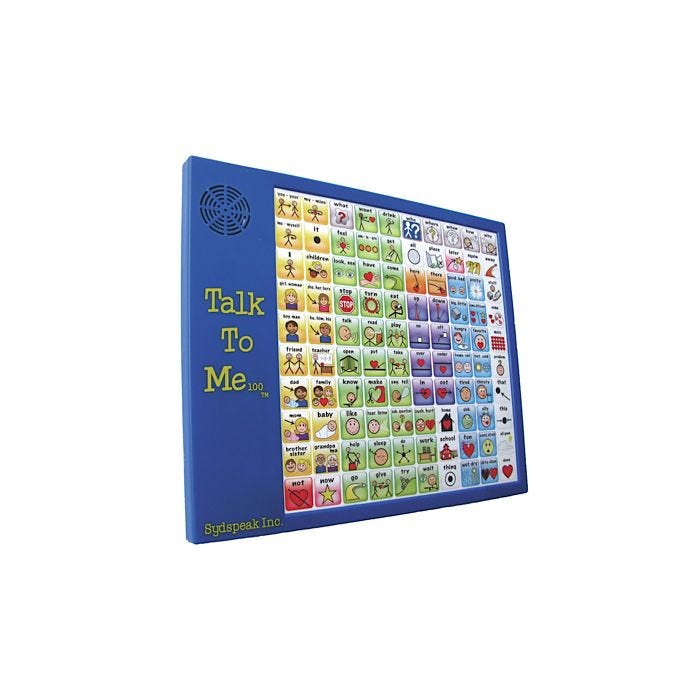Talk To Me 100

Ships Soon
- SKU
- 74158
Product Description
Powerful, interactive tool provides a core vocabulary of 100 words most frequently used in conversation. By pressing buttons the user can see, hear and understand the meaning of these words. Multiple words can even be combined to express complete thoughts. Promotes faster language acquisition and increased verbal expression.
Comes with prerecorded word(s) that each correspond to a switch/button and a location on the overlay indicated with visual symbols. When pressed, each button provides the sound of a single word (or words) that may be combined with a sequence of words to express the individual’s wants, needs and desires.
Talk To Me 100 provides a multi-sensory approach to language learning. Repetitive motor planning required to select a specific location along with the tactile feedback from pressing the button reinforces the muscle memory and association with the corresponding visual (symbol) and auditory (word) cues. Multiple activations of a single button for a variety of activities with different communication partners are important. The behavior reinforces the voice output from the device and the natural voice of the speaker. This process makes the necessary neurological connections in the brain for long term memory, thus increasing probability for verbal expression.
Talk to Me 100 offers an opportunity for effective functional interactive communication for a wide variety of applications: individuals with developmental delay, visual needs, autism, cognitive impairment, hard of hearing, brain injury, motor planning difficulty, cerebral palsy, apraxia, selective mute, voice, speech and language disorders, foreign language, beginning language learners.
Specifications
| Brand | Sydspeak |
|---|---|
| Assembly Required | No |
Reviews
Tips
| Tips | Tips for Success
Begin with baby steps Initially use only 1 and 2 word expressions: “I see.” “Look.” “You go.” Build vocabulary and comprehension slowly. Categories of words — nouns, verbs, adjectives, prepositions, questions — are grouped by color codes, reflecting the organization of language. Expect your child has something to say Look and listen for some form of communication: Gestures, eye gaze, pointing, attempts at speech and words. Give the child at least 10 seconds to respond after you have said something or asked a question. Use words within an activity (action) whenever possible. Acknowledge the child's speech with repetition and a response “You said, ‘Come Mommy.’ Here I come.” Position yourself in the front of the child so that your expressions enhance the communication. Respond to all communication, even if it seems unintentional If your child unwittingly points to the symbol for “thirsty”, respond with, “You said ‘thirsty,’ let’s drink some water,” while pressing the symbols for “thirsty” and “drink.” This will build a sense of competence and self-esteem. Give positive feedback; repeat sounds and words expressed by the child. Take turns speaking. Be genuine Communicate a sincere desire for information. Asking questions the child thinks you already know the answer to — such as “What’s my name? ” — may result in no response or turning away. Talk aloud yourself Use a different expression and tone for self-talk: “I am walking.” Be direct, use eye-contact when speaking to the child: “you are playing.” Talk about activities as they occur naturally. Give logical feedback Don’t say, “You touched the picture.” Do say, “You said ‘eat.'” Reinforce the communication by pressing the “eat” symbol and follow up by offering something to eat. Use 100 word communication board daily and listen to what your child has to say. Have fun Using the 100 words is not a game, but it should seem like one. Enjoy yourself. Enjoy the magic of seeing — and hearing — a child learn to talk. |
|---|
Warnings
| Choking Hazard | No |
|---|---|
| Sterile | No |